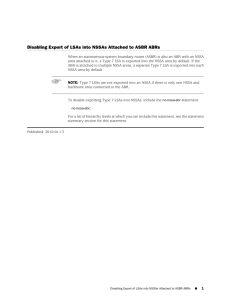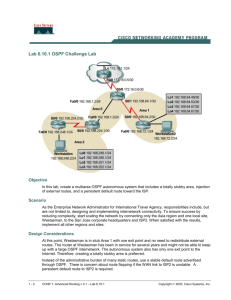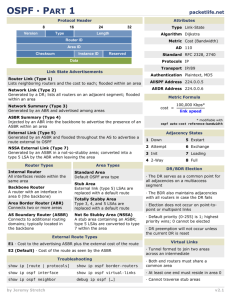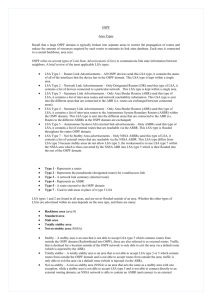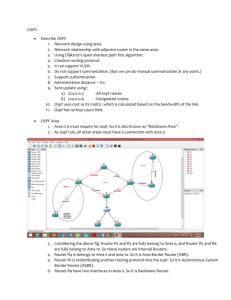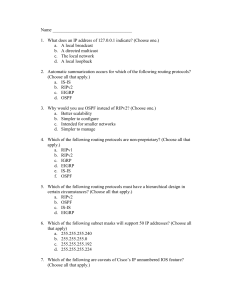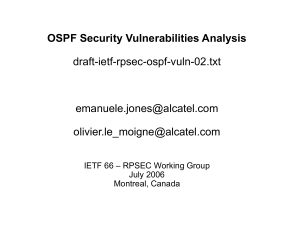ospf-notes
advertisement
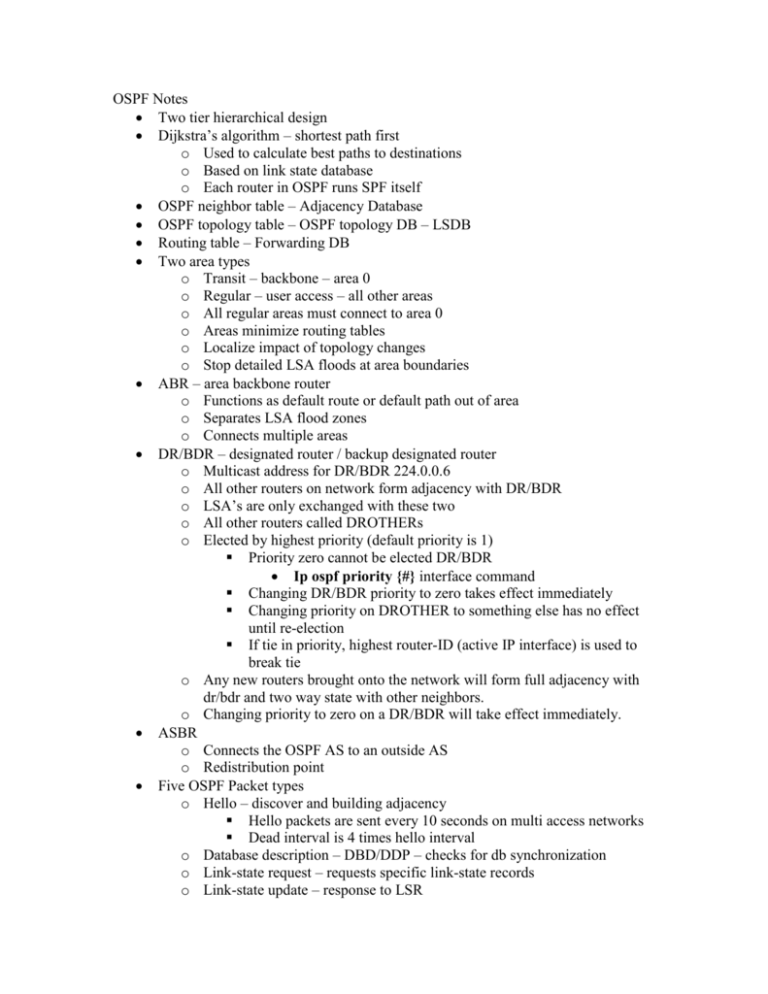
OSPF Notes
Two tier hierarchical design
Dijkstra’s algorithm – shortest path first
o Used to calculate best paths to destinations
o Based on link state database
o Each router in OSPF runs SPF itself
OSPF neighbor table – Adjacency Database
OSPF topology table – OSPF topology DB – LSDB
Routing table – Forwarding DB
Two area types
o Transit – backbone – area 0
o Regular – user access – all other areas
o All regular areas must connect to area 0
o Areas minimize routing tables
o Localize impact of topology changes
o Stop detailed LSA floods at area boundaries
ABR – area backbone router
o Functions as default route or default path out of area
o Separates LSA flood zones
o Connects multiple areas
DR/BDR – designated router / backup designated router
o Multicast address for DR/BDR 224.0.0.6
o All other routers on network form adjacency with DR/BDR
o LSA’s are only exchanged with these two
o All other routers called DROTHERs
o Elected by highest priority (default priority is 1)
Priority zero cannot be elected DR/BDR
Ip ospf priority {#} interface command
Changing DR/BDR priority to zero takes effect immediately
Changing priority on DROTHER to something else has no effect
until re-election
If tie in priority, highest router-ID (active IP interface) is used to
break tie
o Any new routers brought onto the network will form full adjacency with
dr/bdr and two way state with other neighbors.
o Changing priority to zero on a DR/BDR will take effect immediately.
ASBR
o Connects the OSPF AS to an outside AS
o Redistribution point
Five OSPF Packet types
o Hello – discover and building adjacency
Hello packets are sent every 10 seconds on multi access networks
Dead interval is 4 times hello interval
o Database description – DBD/DDP – checks for db synchronization
o Link-state request – requests specific link-state records
o Link-state update – response to LSR
o Link-state ack – acknowledges other packet types
Operational States
o Down
o Init state – routers multicast initial hello (224.0.0.5)
o Two way – routers send unicast hellos listing neighbors
o Exstart – master/slave relationship established with DR/BDR
o Exchange – DDPs are exchanged
o Loading – LSRs for specific networks
o Full – all LSDBs are synchronized with DR/BDR. Routers are able to
route traffic
Communication
o 224.0.0.5 multicast to everyone
o 224.0.0.6 multicast to DR/BDR
o LSAcks are sent unicast
o LSDB summaries are multicast every 30 minutes
Entries have a max life of 60 minutes
o 32 bit sequence numbers are used for link-state advertisements
The sequence number can be seen with the “show ip ospf
database” command
o Loopback interfaces are recommended for stability and RID
RID can be manually set using router-id router configuration
command
If RID was set with loopback, a router reboot is required
for the router-id command to take effect
If RID was set with router-id command, it can be changed
with “clear ip ospf process” command
Network Types
o Point to Point
Multicast 224.0.0.5 to discover neighbors
No DR/BDR
ip unnumbered is possible over point to point links
10/40 hello/dead interval
o Broadcast
DR/BDR are the central point of contact in the network
o Non broadcast multi-access
By default, OSPF cannot form neighbor adjacencies
DR/BDR elections become crucial
Hub/spoke, not all spoke sites can communicate directly
Three topologies
Full mesh – costly, requires separate VC’s for connectivity
between each site
Partial mesh
Star – hub/spoke
Modes of operation
Ip ospf network {mode} interface command
Broadcast – Cisco Proprietary
mode
bcast
non bcast
p2mp
p2mp nb
p2p
prefer topo
Full/partial
Full/partial
Partial/star
Partial/star
Partial/star
o WAN links are treated like LAN interfaces
o Multicast hello for discover
o Full/partial mesh
Non broadcast – RFC Compliant
o One IP subnet for all spokes
o Neighbors are manually configured
o DR/BDR is also manually rigged/configured to
insure connectivity to DR
Point to multi-point – RFC Compliant
o Multicast hello for discover
o No DR/BDR (requires additional LSAs)
o Mesh/star
point to multi-point non broadcast – Cisco Proprietary
o Used in place of P2MP where broadcasts and
multicast are disabled
o Neighbors are manually configured
point to point – Cisco Proprietary
o Different IP subnet on each interface
o No DR/BDR elected or needed
o LAN or WAN interface
Default Modes
o Point to point FR – point to point mode
o Multipoint FR (subinterfaces) – non broadcast
o main FR interface – non broadcast
NB mode neighbor configuration
o Neighbor {ip} priority {# default 0} poll-interval
{#} cost {1-65535} database-filter all
subnet
Same
Same
Same
Same
Diff
hello timer
10 sec
30 sec
30 sec
30 sec
10 sec
adjacency
Auto DR
Manual DR
Auto no DR
Manual
Auto no DR
RFC
Cisco
RFC
RFC
Cisco
Cisco
example
LAN
FR
FR bcast
FR nbcast
serial/sub
LSA Types
o Router LSA – type 1
IntraArea LSA generated by every router in the area. Advertises
link states. The LSID = RID of originator
o Network LSA – type 2
Network LSA generated for Multiaccess networks
Generated by DR – LSID = RID of DR
o Summary LSA – type 3
Summary advertisements generated by ABR
Summarizes type 1 LSAs from one area to another
Describes routes to area’s networks (aggregate routes)
LSID = destination network #
Not flooded to stubby, totally stubby, or not so stubby areas
Routes are NOT automatically summarized
o Summary LSA – type 4
Generated by ABR to advertise the presence of an ASBR. ASBR
sends type 1 with e-bit set to ID itself
Routes to ASBR
LSID = RID of describe ASBR
Not flooded to stubby, totally stubby, or not so stubby areas
Routes are NOT automatically summarized
o AS External LSA – type 5
Generated by ASBRs to advertise external networks and
autonomous systems. LSID = external network #
Contains all routes separately, unless manually summarized
ABRs pass type 5 LSAs on to the rest of the AS
o Multicast OSPF LSA – type 6
o NSSA External LSA – type 7
ASBR in a stubby area that needs to pass external routes back into
the AS. Stubby area needs to be reclassified as NSSA to allow
those routes.
ABR receives type 7 LSAs and forwards them as type 5 to the rest
of the AS
o External LSA for BGP – type 8
Cost/Metric
o 100mbps/link speed = cost
Example 100mbps interface has cost 1
Unfortunately, 1000mbps interface also has cost 1
Auto-cost reference-bandwidth {ref bw} interface
command to change this behavior
bandwidth {value} interface command to define actual bandwidth
ip ospf cost {value} interface command
Route summarization
o Occurs at ABRs, relies on contiguous IP design
o Area # range {addr | mask} advertise/not-advertise cost {#}
o Router will create a summarized route to null 0
o ASBR Summarization
Summary-address {addr | mask } tag router config command
Default route
o Default-information originate always metric {value}
o Per Cisco, default metric of 10.
OSPF Area Types
o Standard Area
Accepts link updates, route summaries, and external routes
o Stub Area
o
o
o
o
o
Blocks type 5 LSAs. No routes external to the AS. If stubs need
to connect to external AS, they use default routes.
Totally Stubby Area
Blocks type 3, 4, and 5 LSAs. No external AS, no summary
routes. Uses default route for everything outside of the local area.
Not So Stubby Area
Acts like a stub/tsa but allows ASBR connected to it
ASBR in an NSSA generates type 7 LSA
ABR to NSSA translates Type 7 to Type 5 before passing along to
the rest of the AS
Routes from Type 7 LSA show in routing table as O N1 or O N2
(type 2 is default)
Stub/TSA/NSSA configuration
Area # stub router configuration command on all routers in area
Area # stub no-summary router configuration command on ABR
for TSA
area # nssa no-summary
Virtual Links
Allow extension of Area 0 through another area
Area # virtual-link RID where RID is the RID of the neighbor on
the other side of the VL
sho ip ospf virtual-links
Helpful commands
Sho ip ospf neighbor
Sho ip ospf database
Sho ip ospf adj this is ADJ, not adjacency!!!!!!


